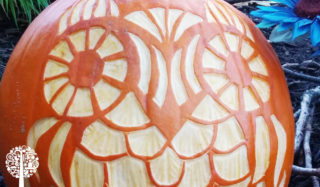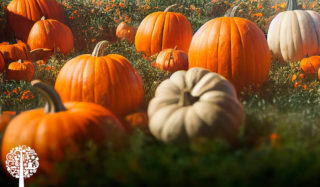The pumpkin patch has been nurtured, watered, and watched with eager eyes all summer. First, the lovingly planted seeds sprouted leaves, and then, telltale yellow flowers appeared, eventually transforming into large balls of bright orange. Now, right on time for Halloween, farm fields are a hive of activity with hayrides and pumpkin harvests. The perfect jack-o’-lantern is out there, and with a few tips and tricks, you will find it!
Plan Ahead: To Carve Or Bake?
It helps to plan, so think about what you’d like to carve. For instance, a ghost might appear spookiest on a pumpkin that’s narrow and tall, whereas a creepy crawly tarantula will look foreboding on a chubby squat pumpkin. Sometimes you can find heirloom varieties with deep ribbing or bumpy skin, both features that add spookiness to any carving.
While all pumpkins are edible, some are better for cooking than others. Often labeled as sugar or pie pumpkins with various sub-varieties such as Baby Pam or Ghost Rider, these varieties have smooth textured skin and are sweeter than the stringy, watery, often bland-tasting ones grown for carving.
When To Harvest
The Farmer’s Almanac recommends harvesting your pumpkin from a field on a dry day when moisture on its skin has evaporated. This will help keep your pumpkin firmer and fresher longer.
Don’t carve your pumpkin too early; three to five days before Halloween is the max; otherwise, it won’t be too fresh-looking on the big day.
Colour and Sound
The darker orange the pumpkin, the riper it is. Choosing a pumpkin is similar to selecting a cantaloup or watermelon; knock on its side with your knuckles, and the louder it echoes and the hollower it sounds, the fresher it is.
Stem
The stem gives a good indication of how fresh the pumpkin is. The stem acts like a wick on the vine and pulls the water from inside the pumpkin to help it ripen. Look for a medium green stem; this indicates the pumpkin is fresh or has been recently harvested. A dark brown-colored stem signifies an older gourd that won’t last as long.
Skin
Another good sign that a pumpkin is ready for harvest is the skin’s firmness. Use your fingernail and poke the pumpkin rind; if it springs back or doesn’t give, it’s ready.
Bottom
The last thing to check for is the bottom of the pumpkin. If it’s mushy or soft, the pumpkin has begun to rot. So make sure to pick a pumpkin with a firm flat bottom so it won’t fall over when all those ghosts and goblins come trick or treating.
Whether it’s a trip to the pumpkin patch, farmer’s market, or grocery store, once you have found the perfect pumpkin, ensure that once you get it home, keep it in a cool, dry place. Don’t expose it to temperatures below 0°C; it will last for days. Cooked or carved pumpkins are the quintessential fall harvest, great in a pie or soup, or at their spookiest, carved to celebrate all things Halloween!

